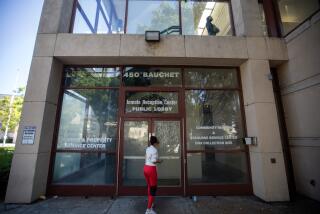4 Ill, 300 Evacuated at Navy Base
- Share via
PORT HUENEME — Toxic chemical fumes sickened four civilian employees at a military base Thursday and forced the evacuation of more than 300 additional workers, authorities said.
The incident occurred shortly before 11 a.m. in a small room at the two-story Naval Surface Warfare Center, just inside the western boundary of the U. S. Naval Construction Battalion Center.
“They accidentally made a mixture that released chlorine gas,” base spokeswoman Terri Reid said of the incident.
The employees had been cleaning a water cooling system when one of them poured more than two gallons of a high-concentrate chlorine solution into pipes that already contained another volatile cleaning agent, officials said.
The mixture caused a vapor cloud that filled the room and filtered through the building. Emergency workers who arrived minutes later said they could smell the fumes from a block away.
Five buildings within 150 yards of the accident scene were cleared of people, and dozens of residents on Island View Avenue in Silver Strand--a beach community about 200 yards away--were alerted to the situation by sheriff’s deputies.
“There were no evacuations in that area, but there was a contingency plan in place in case the incident escalated and there was a threat. Some residents were told to stay inside,” said Joe Luna, a county Fire Department spokesman.
The injured--four men who work for a company that contracts with the Navy--were taken by ambulance to hospitals in Ventura and Oxnard. They were treated for breathing troubles and released, hospital spokeswomen said.
A female county probation officer in the building on business drove to a Camarillo hospital to be evaluated. She was released after showing no signs of trauma.
Base officials refused to disclose the names of the injured.
“Chlorine gas can kill you; that’s why it’s classified as a poison,” said county Fire Capt. Tom Roberts, one of more than a dozen hazardous-materials specialists who responded. “If it doesn’t kill you, it can cause extreme distress to the respiratory tract and a chemical reaction to the skin.”
The incident occurred in a second-floor mechanical room where the water-treatment cooling system is stored, Reid said. At the time, several dozen people were working throughout the building.
The contractors mixed a chlorine solution that measured between two and seven gallons, Reid said. After the gas cloud formed, they sounded a fire alarm, opened some windows, then evacuated.
Dozens of firefighters from the county, the naval base and the cities of Oxnard and Ventura helped evacuate the 300 to 400 workers. The workers--both military personnel and civilians--were mostly engineers, technicians and administrative employees. Many were herded more than a block away.
After allowing the building to air out for about two hours, six hazardous-materials specialists outfitted in chemical-resistant “moon-suits” went inside to test the air for toxins, according to Roberts.
Although the odor of chlorine lingered for hours, tests for chemicals in the air inside the building were negative, base officials said.
By about 2 p.m., all employees who had been evacuated were allowed to return and retrieve personal belongings. Nearly all the workers were sent home for the rest of the day, Reid said.
“It was safe to reenter, but there was still a residual odor,” Reid said.
This was the base’s second spill involving chlorine in three years.
On Aug. 11, 1996, 70 people were exposed to toxic fumes and 28 were hospitalized after a cleanup crew mixed chlorine and ammonia while cleaning the barracks.
All of the victims recovered.
In addition to breathing problems, chlorine gas can, if ingested, cause severe nausea, and head and chest pains. If breathed in sufficient quantities, it can cause a build-up of fluid in the lungs that can be fatal.
Susie Wong, state Office of Emergency Services spokeswoman, said Thursday that of 5,199 hazardous-materials spills in the state in 1997, the most recent full-year statistics available, 75 involved chlorine.
Between January 1995 and April 1998, there were 199 chlorine spills reported to the state office.
The number of chlorine spills in California has risen since 1995, when 45 were reported. In 1996 there were 50, and there were 29 in the first four months of 1998.
More to Read
Sign up for Essential California
The most important California stories and recommendations in your inbox every morning.
You may occasionally receive promotional content from the Los Angeles Times.













